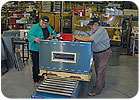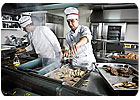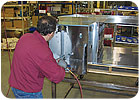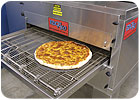
When most people think about appliances, household dishwashers and refrigerators often come to mind. But, food service equipment also accounts for an important segment of the appliance industry. Restaurants, hotels, bakeries, hospitals, schools, prisons, convenience stores, nursing homes, delis, grocery stores, country clubs and other institutions use a wide variety of specialized ovens, coolers, freezers, fryers, ice makers, disposers, dishwashers, meat slicers, scales, rotisseries and other items.
Demand for food service equipment has grown steadily over the last decade, driven by population growth, diverse lifestyles and demographic changes. The North American Association of Food Equipment Manufacturers (NAFEM, Chicago) says the U.S. market accounts for approximately one-third of the $20 billion global industry. The development of new restaurant concepts, such as quick-service and casual-theme chains, and the ongoing expansion of U.S. chains into international markets is expected to fuel future demand.
Because the products are often used continuously, day in and day out, most food service equipment is built with heavy-duty parts that can withstand constant wear and tear, such as cast-iron burners, metal gears, and large knobs and dials made from polyphenylene sulfide. Stainless steel is widely used in the industry, because of universal demand for corrosion resistance, durability and hygiene.
The concept of planned obsolescence does not apply to food service equipment. It’s not uncommon for products to have a 20-to-30-year lifecycle. And, unlike many other industries, most food service equipment is still assembled domestically. In fact, the United States is a leading exporter of ovens, refrigerators and other commercial appliances.
Food service equipment is typically built to order on high-mix, low-volume assembly lines using lean manufacturing princi-ples. “Everyone likes their equipment specialized,” says Dave Brewer, chief operating officer of Middleby Corp. (Elgin, IL), which manufactures a wide variety of commercial ovens, broilers, fryers, griddles, holding cabinets and ranges. Approxi-mately one-third of its business comes from equipping new restaurants and institutions; the remainder comes from persuading end users to upgrade their kitchens.
“There are a lot of specialty products and one-off designs in the food service equipment industry,” explains Brewer, who is an engineer by training. “For instance, there are many different types of burners and different vat sizes to meet special needs. Our customers use unique kitchen designs that allow them to produce unique types of food or service.”
According to Brewer, there is also a huge variation in equipment used at national fast-food chains such as Burger King and Taco Bell, even though the kitchen workflow is often standardized. For instance, the pizza ovens used by chains such as Domino’s, Little Caesars and Pizza Hut typically look the same from the outside. But, the metal “fingers” that direct heat inside the ovens are unique and proprietary. They determine how hot air blows over and under pizza to address customers’ unique requirements for recipes and cooking processes, such as thin-pan vs. thick crust.
“Food service equipment tends to be well-built and very expensive,” says David Zabrowski, director of engineering at the Food Service Technology Center (FSTC, San Ramon, CA). “If the equipment malfunctions, a restaurant or institution could be out of business.”
Unfortunately, food service equipment has a notorious appetite for electricity, natural gas and water. The U.S. industry annu-ally consumes $10 billion worth of energy. That’s because ovens, ranges, fryers and other appliances run constantly in a commercial kitchen. Buildings that contain restaurants or other commercial kitchens consume approximately 2.5 times more energy per square foot than other buildings. In a typical food service operation, cooking accounts for approximately 30 percent of energy consumption, followed by refrigeration (19 percent) and sanitation (10 percent).
“Unlike home appliances, there’s a lot of downtime between when appliances are used in the food service industry,” says Zabrowski. “Restaurateurs never know when the next order will come in. As a result, it’s not unusual for commercial equipment to sit idle 80 percent of the time.”
“Idle time is a factor that causes significant energy waste in food service equipment,” adds Tom Debin, CEO of Equity Thru Energy (ETE, Placentia, CA), a leading energy management firm. “Turning off equipment and lights, or using timers for when they are not in use, can save a commercial kitchen thousands of dollars a year.”

Demand for food service equipment has grown steadily over the last decade, driven by population growth, diverse lifestyles and demographic changes.
New Opportunities
Energy efficiency is creating numerous challenges and opportunities for food service equipment manufacturers. According to NAFEM, no single issue has done more to spark green awareness than energy.“Traditionally, productivity issues, such as how much food can be produced, reliability and maintenance, are critical to food service operators when they specify equipment,” says Zabrowski. “But, energy efficiency is now equally important, because energy prices have doubled over the last 20 years. Today, energy is a restaurateur’s largest operating cost after ingredients and labor. Energy now accounts for 5 percent of operating costs vs. 2 percent in the late 1980s.”
As operating costs keep going up, commercial kitchen operators are focusing more attention on energy. “In the past, speed was the most important criteria in the food service equipment industry,” says Bill Schjerven, vice president of engineering at Middleby Marshall (Elgin, IL). “Today, it’s still important, but it’s taken a back seat to energy efficiency.”
“Everyone is looking for green opportunities today,” adds Brewer. “Some customers are still leery that it’s just a gimmick or a fad. But, many more see it as something that really affects their bottom line.”
Commercial appliances are usually used extensively, for at least eight hours a day. “As a result, lifetime operating costs often exceed the initial purchase price, and therefore, efficiency represents substantial savings,” explains Angelo Grillas, director of marketing at Electrolux Professional Inc. (Fort Lauderdale, FL). “That makes energy-efficient performance a paramount interest for a hotel, restaurant, school, hospital or any other operation using food service equipment on a daily basis.”
“Restaurateurs and other food service operators may see the equipment as being more costly simply because of the initial cost of replacement, but those who make the switch see savings to warrant the up-front costs,” claims Debin.
At the National Restaurant Association (NRA) Show in Chicago last month, energy efficiency was a hot topic, because large and small restaurateurs are eager to save money today. “Saving money and cutting costs are crucial aspects of running a business in this current economic environment, and ‘going green’ can accomplish both, while also being the socially responsible thing to do,” says Lorna Donatone, chairperson for the 2009 show and president of the school services division of Sodexo Inc. (Gaithersburg, MD).
“Restaurant operators [face] a host of challenges, including cost pressures [and] declines in consumer dining demand,” adds Ron Paul, president of Technomic Inc. (Chicago), a food service industry consulting firm. “Sales growth among the top 500 restaurant chains slipped to 3 percent in 2008 vs. 5 percent in 2007.” That trend is expected to continue this year, as the industry reacts to the slow economy.
According to Paul, restaurateurs are embracing green initiatives by reducing energy and water use. Approximately 40 percent of full-service restaurant operators and nearly 30 percent of quick-service operators recently surveyed by the NRA claim they plan to devote more of their 2009 budgets to green initiatives.
Large chains tend to be more focused on the economic benefits of sustainability. “I wouldn’t say that chains are more energy-conscious than independent operations, but they may have more resources devoted to it,” notes Annika Stensson, an NRA spokesperson. “Most chains currently monitor their energy usage and make plans for energy-conserving measures accordingly. We’re encouraging all restaurants to do what they can and tailor their sustainability efforts to what fits their operation the best.”
Several large industry players, such as McDonalds and Subway, have jumped on the green bandwagon. For instance, McDonald’s Corp. (Oak Brook, IL) developed a “kitchen of the future,” which aims to lower energy consumption and increase operational effectiveness. It also operates several experimental restaurants, including one in Chicago that consumes 25 percent less energy than its other outlets.
Last year, the NRA launched a voluntary initiative called Conserve that focuses on independent restaurateurs. “Since not all restaurants can commit financial resources to environmentally friendly upgrades, [we aim] to provide tools and resources on ways to go green at little or no cost,” Stensson points out. “We’re not asking everyone to abandon all their current equipment, but to keep energy and water in mind next time they purchase equipment.
“Those who can make investments now will see almost immediate return in the form of lower utility bills,” claims Stensson. “There are also tax incentives available in some areas.” For instance, more than 12 states offer rebates that cut hundreds of dollars off the price of new energy-efficient food service equipment.
Electricity tends to be more efficient than natural gas in commercial kitchens, but electricity rates are more volatile and fluc-tuate widely in different parts of the United States. Constraints on the electric grid contribute to some of that discrepancy. As a result, chain restaurants maintain dual equipment standards so they can use electric or gas equipment to take advantage of local prices.
“We’re just at the beginning of the green process,” says Zabrowski. “Food service equipment has a long lifespan and doesn’t get changed very frequently. The installed base of energy-efficient equipment is currently less than 10 percent. We need to continue to educate the industry and develop standards for more equipment categories.”
“The energy-efficiency movement has just taken off within the last year,” adds Michael French, president of MF&B Restau-rant Systems Inc. (Dunbar, PA). His company recently unveiled a new gas-powered oven that costs 20 cents less per hour to operate than its older equipment.
“The largest challenge that needs to be addressed by the food service industry is published gas usage and electrical usage data for the consumer,” claims French. “There’s still a number of misperceptions and confusion in the marketplace. Manufacturers often say their product is ‘more efficient,’ but they never say what that’s compared to. We all need to do a better job communicating this information to our customers.”
Thanks to organizations such as NAFEM, which offers a life-cycle costing program to its members, the industry has taken steps to address the issue. “At first, some food service equipment manufacturers were just reselling existing products and trying to market them in a different way,” says Middleby’s Brewer. “But, many companies have now begun to focus on energy-efficient product development. This is an exciting time to be an engineer in this industry.”

Food service equipment is typically built to order on high-mix, low-volume assembly lines.
Federal Guidelines
Many observers believe energy efficiency will become even more important under the Obama administration, with federal agencies stepping up efforts to mandate or enforce strict guidelines. “Energy efficiency is a journey that the food service industry must be a part of to survive,” claims ETE’s Debin. “There are varying stages for a [commercial kitchen] to increase its energy efficiency. I think most restaurants are in the preliminary stages.“If a restaurant is aware of how much energy is being used, then decisions can be made to address the high cost [of] energy,” Debin points out. “It is critical for restaurant owners and managers to get on board. We are headed toward an increase in energy cost that will multiply by 10 times the normal rate during peak hours. Like it or not, it’s going to be mandated.”
The green movement in the food service equipment industry began several years ago with a federal government initiative called Energy Star. It is a voluntary, market-based program that has existed since 1992 for consumer appliances. A commercial equipment category was added in 2001.
Energy Star is jointly administered by the U.S. Department of Energy (Washington, DC) and the U.S. Environmental Protection Agency (EPA, Washington, DC). Manufacturers test their electric- and gas-powered products using standard methods developed by ASTM International (West Conshohocken, PA).
Products that meet certain requirements in six categories, such as commercial dishwashers, fryers, hot-food holding cabinets, ice makers, reach-in refrigerators and freezers, and steam cookers, are allowed to display a blue-and-white star logo. For example, steam cookers that earn an Energy Star must meet a minimum cooking efficiency of 50 percent (electric) and 38 percent (gas), while also meeting maximum idle energy rates.
When a new Energy Star requirement for commercial refrigerators and freezers takes effect early next year, qualifying models will be 33 percent more energy-efficient than standard models. If all commercial refrigerators and freezers sold in the United States meet the new specification, EPA officials claim the energy savings would grow to $275 million per year and prevent greenhouse gas emissions equivalent to those outputted from nearly 400,000 vehicles.
Outfitting an entire kitchen with a suite of Energy Star-qualified food service equipment could save end users 10 percent to 30 percent on their utility bills. For example, a commercial dishwasher that earns a star is 25 percent more water-efficient than standard models.
“Energy Star has had a huge effect on the food service equipment industry,” claims Brewer. “All of a sudden, it’s become an incredible resource for everyone.”
Because of its popularity, Energy Star is currently being expanded to include more equipment categories. For instance, a new specification for griddles was unveiled at the NRA show last month. A convection oven standard will be announced later this year.
But, Energy Star isn’t the only green benchmark available for food service equipment manufacturers. The Consortium for Energy Efficiency Inc. (CEE, Boston) is a membership organization made up of electric and gas utilities, in addition to state energy offices. It has a Commercial Kitchens Initiative that promotes the use of energy-efficient food service equipment.
“The initiative provides consistent definitions for high-performance products, making it far easier to identify energy- and water-saving equipment,” says Sarah Griffith, a CEE spokesperson. “Commercial kitchen owners and operators can then work with local utilities to select equipment that is cost-effective and meets the needs of their business.” Many utilities that are members of CEE, such as Bonneville Power Administration (Portland, OR) and Pacific Gas and Electric Co. (San Francisco), provide financial incentives and rebates to encourage their customers to purchase green appliances.
Some observers believe that CEE has a more stringent policy than Energy Star. For instance, CEE’s Tier II specification is more efficient than Energy Star for refrigeration equipment. As a result, some experts predict that the organization will eventually become the dictator of energy-efficiency standards in the food service equipment industry.

Food service equipment has a notorious appetite for electricity and natural gas, because ovens and other appliances run constantly in commercial kitchens.
Energy-Efficient Components
There are several ways that engineers can make food service equipment more energy efficient. But, new components that reduce electricity, gas and water consumption often make products more expensive and assembly more complex.For refrigeration equipment, compressors and motors play a key role, in addition to defrost controls. Many manufacturers are using electronically commutated motors, which are brushless DC devices where the direction of the electric current is switched using electronic controllers. They use less than one-third the electricity consumed by traditional induction motors.
Engineers are also experimenting with new types of burners and heat exchange systems for commercial cooking equipment. “The use of modulating burner systems has changed gas usage greatly from 10 years ago when we only used traditional on-off burners,” says MF&B’s French. “Today, we are engineering our products to be more energy efficient by incorporating a new style of gas burner and designing more efficient ways to move air.
“The two main components we use to make our EDGE series of ovens more efficient are modulating burner assemblies and blower fans,” French points out. “By controlling both gas and air flow, the burner can attain maximum efficiency through its entire firing range.”
For cooking equipment, French says the biggest challenge is “being able to maintain a high quality bake in a short period of time, while using less gas. We are addressing this challenge by using a modulating burner designed by Wayne Combustion Systems (Fort Wayne, IN).”
Whether it’s for cooling or heating applications, insulation and digital controls also play a critical role in energy efficiency. The Food Service Technology Center operates an extensive testing laboratory that measures the effectiveness of different types of equipment.
“Insulation is underutilized in the food service equipment industry,” says Zabrowski. “Insulation is the universal easy-fix solution. It will reduce the amount of cold or heat loss in any appliance.” For instance, in refrigeration units, inefficient sealing is a huge issue. Refrigerators need to work extra hard to keep temperatures down when there isn’t correct insulation.
Engineers rely on a wide variety of sensors, switches and controls to measure and monitor energy consumption in commercial appliances. “Digital electronic controls are making an impact on the energy efficiency of today’s food service equipment,” claims Paul Carlson, president of Control Products Inc. (Chanhassen, MN).
“Controls with external communications, such as Modbus and ZigBee, are nearly the standard for new electronic designs [in the industry],” adds Carlson. “External communications with digital controls opens up a whole range of energy conservation possibilities. Communications are used for factory programming, field service access, remote monitoring, remote control and data collection.” A
To learn more about foodservice equipment manufacturing trends, clickwww.assemblymag.comand search forStainless Steel Challenges.
